SS Canberra 1961 Introduction, Construction,
Ships layout, History & Original Deck Plans
Please Note: Firefox and some other Search Engines may not be suitable
Use Google Chrome for this Web Page to load perfectly!

Click the logo above to reach the
ssMaritime FrontPage for News Updates & “Ship of the Month”
With Reuben Goossens
Maritime Historian, Cruise‘n’Ship
Reviewer, Author & Lecturer
Please Note: All ssMaritime and other related maritime sites are 100% non-commercial
and privately owned, thus ssmaritime is NOT associated with any shipping
company or any other organisation! Although the author has worked and been
involved in the passenger shipping industry for well over 60 years, but due to
his old age and poor health, he was forced to retire. Yet, he has completed
well over 1,550 Classic Liners, Passenger-Cargo Liners as well as humble
converted C3 converted Migrant Liners, which has transported countless
thousands of folk to the new world, as well on vacations’. Amazingly,
ssmaritime.com has received 573.4 million visitors to date I trust the features
online will continue to provide Classic Liner and Ship enthusiasts both the
information they are seeking, but more so provide a great deal of pleasure and
relive many happy memories!
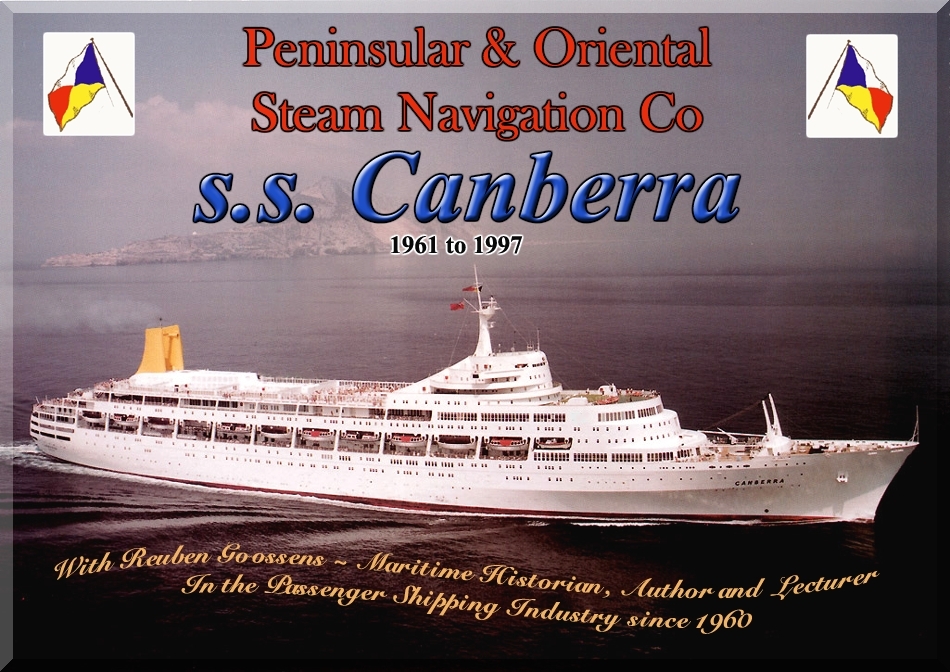
Page One
A
Ship in Planning & Construction
&
Her Voyage History from 1961 to 1963
Introduction:
Personally I go right back to her maiden
voyage, which was beset with problems with the “condenser” to the
“portside turbo-alternator” and this delayed her arrival in
Australia, but she did make up some time after she departed Sydney and crossed
the Tasman Sea for Auckland New Zealand were I lived at that time. Of course,
nothing was going to stop me being quayside for the maiden arrival of this fine
new P&O liner. Having arrived early, I managed to obtain the perfect spot
on the top level of Princess
Wharf,
right at the end and close to the actual berthing side. There we thousands of
people scattered on both sides of the harbour and the Passenger terminal was
complexly packed awaiting her. Then she finally came into sight and we watched
this graceful ship sail slowly past Rangitoto
Island
and head through Waitemata
Harbour
towards the Port
of Auckland
being in the heart of the city. The Canberra then slowly pulled up to Princess
Wharf and as seen from the height I was on, she was without a doubt a most
amazing sight to behold, she was indeed a ship that was designed for a long
future but I realised that this ship would somehow never age and as we know she
never did!
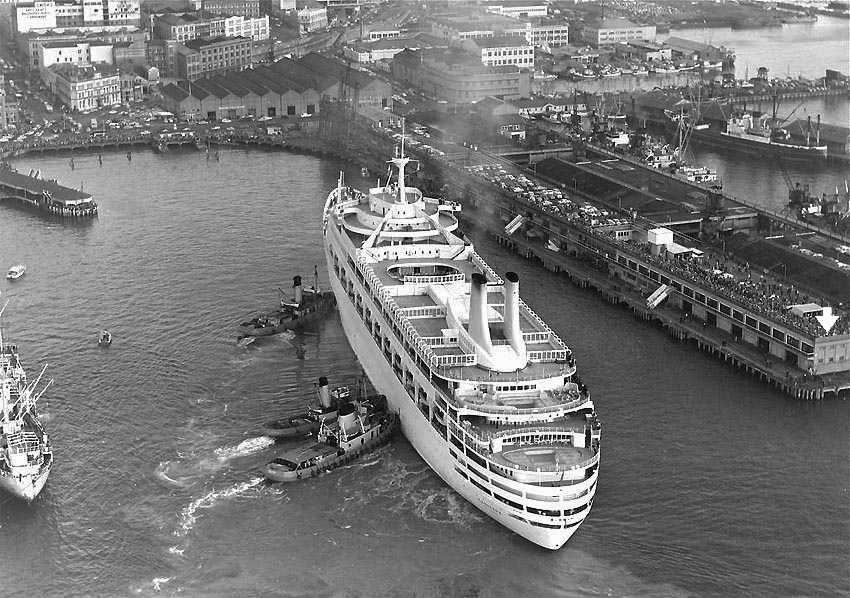
SS Canberra is seen about the berth at Princess Wharf & Passenger Terminal in Auckland
on July 6, 1961
The author can only just be made out on the roof of
the passenger terminal wearing his white Panama hat!
From my vantage point her lines looked so
long and sleek and combined with her superbly designed forward superstructure
right up to what seemed like the Bridge located up so high, but then at the
rear this towering deckhouse was so beautifully stepped back, or as it looked
like curved deck by deck towards the Sports deck below, it was indeed sheer
perfection!
Thus my first impression was that this
ship was very impressive, so much more than the Orient Line’s SS Oriana,
which arrived on her maiden voyage in December 1960, for the Canberra was
sublimely modern, a modern type of ship like we had never seen before, like we
had not seen before, whilst the Oriana, was grand, but somewhat boxy in her
design!
Note of Interest: 1. The SS Oriana did certainly become one of my greatly loved ships
as I sailed on her many times, as I did on the Canberra.
2. In regard to the two ships speed The SS Canberra was never as fast as the SS
Oriana that operated at an incredible service speed of 27.7 knots and had an
available top speed up to 30.64 knots. Although the Canberra was supposed to be
able to operate at 27 knots but she seldom did, in 1973 her service speed was
reduced to 23.5 knots, but she never managed a top speed of 30 knots, but this
never made her less of a ship as these pages will attest to!
I trust you will enjoy this SS Canberra
feature that include several Photo Pages and you will also find a number of
accurate Deck Plans covering her from 1961 to when she became a One Class ship!
It is my sincere hope that looking back at this great liner and cruise ship
will provide you with countless joyful memories, be it as a past passenger, a
crewmember or one of countless thousands who admired her sheer beauty whilst
she was in port!
Reuben Goossens,
Maritime Historian.
Ships Already in Service:
In 1955 the Peninsular & Oriental
Steam Navigation Company, or P&O-Orient Line operated four liners fulltime
on the Australian service; these were the RMS Strathnaver of 1931 and the
Strathaird of 1932, as well as two more recent liners the RMS Arcadia and Iberia
both completed in 1954.
As built the two “Straths” as
they were lovingly called, had three funnels a fore and the aft main mast, thus
they were elegant looking traditional liners! They were the very first liners
to feature an all white hull with a corn to yellow funnel. All previous
P&O-Orient liners had black hulls with a white band surrounding the hull
and what was called a “stone” colour upper hull and superstructure,
which was in reality more of a corn colour and they also had a black funnels!
However, after WWII Trooping duties, the
Strathnaver and her sister the Stratheden were refitted. The Strathaird
returned to their builder, Vickers-Armstrong, Barrow and all her funnels were
removed and a new single slimmer and taller funnel was added where the middle
had been. She returned to service in January 1950. The Strathnaver was sent to
Harland & Wolff in Belfast
o be refitted and had the same treatment as well as all the internal
restoration. She returned to duties five years later in January 1950. Four
years later both ships were modernised and became One-Class liners. Both ships
made their final voyages to Australia
from Tilbury in December 1961, before being broken up in Hong
Kong in 1962.
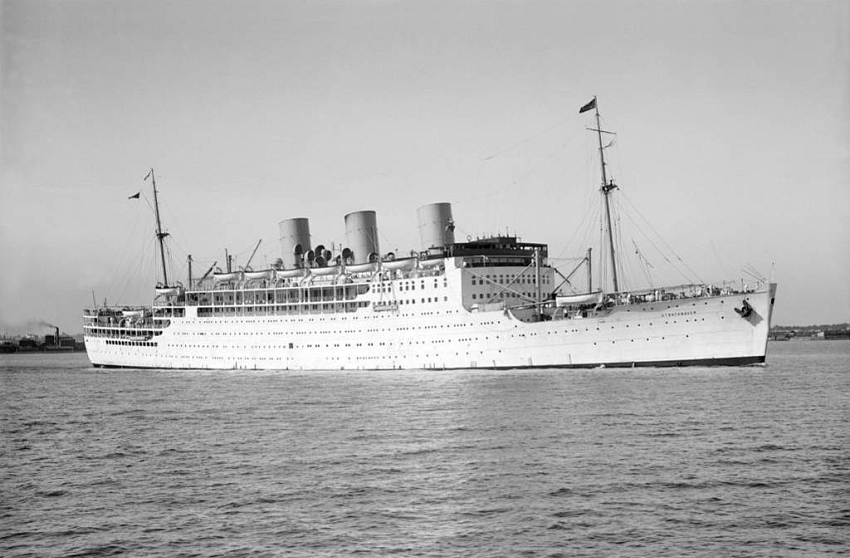
Here we see the RMS Strathnaver as built with three
funnels, after WWII both ships sailed with a single funnel
The RMS Arcadia was the first of the
modern liners and she was soon followed just seven months later by her sister
the Iberia.
Both ships operated as First and Tourist class ships, but in 1970 they were
converted as One-Class ships as cruising had become popular, and the class
system was dying! Iberia
was the first to be sold to the breakers in 1972, whilst the Arcadia
continued until 1979.
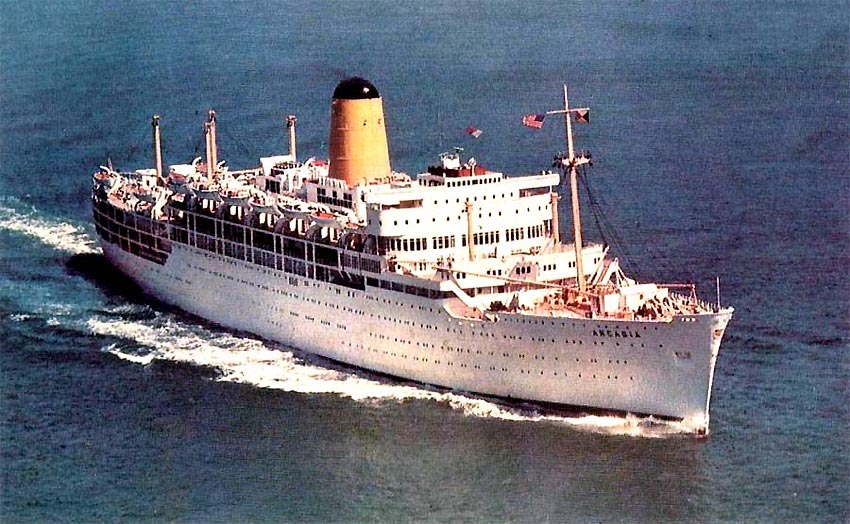
A P&O Postcard of the RMS Arcadia seen in her
later years
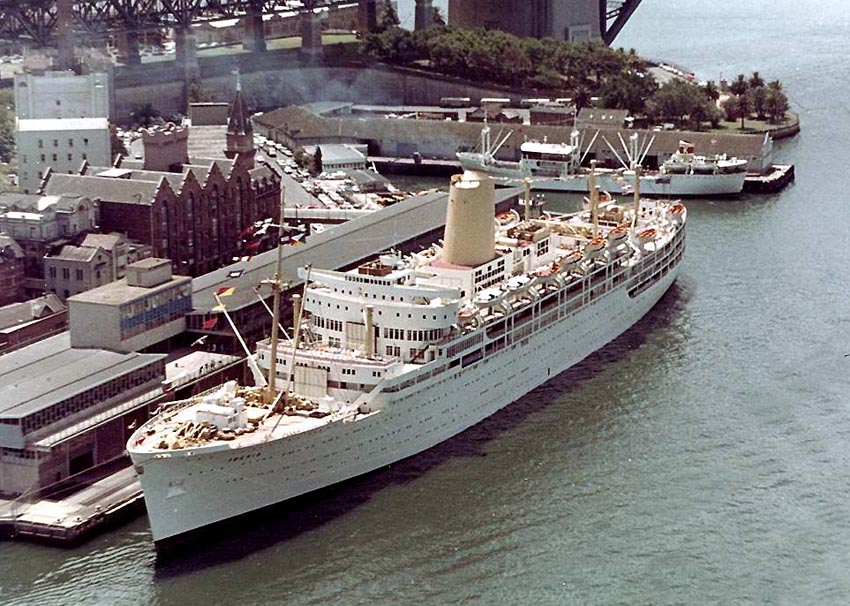
RMS Iberia is seen at the International Passenger
Terminal at Circular Quay Sydney
Photograph by Stan Evens - Newcastle
Australia
As the aging “Straths” were
coming at the end of their career, Peninsular & Oriental Steam Navigation
Company decided that they really needed to commence to making plans urgently
for a new and a larger liner to replace these two old ships. In addition, she
would have to be a liner that would take the company into the future!
Creating and Building the SS Canberra:
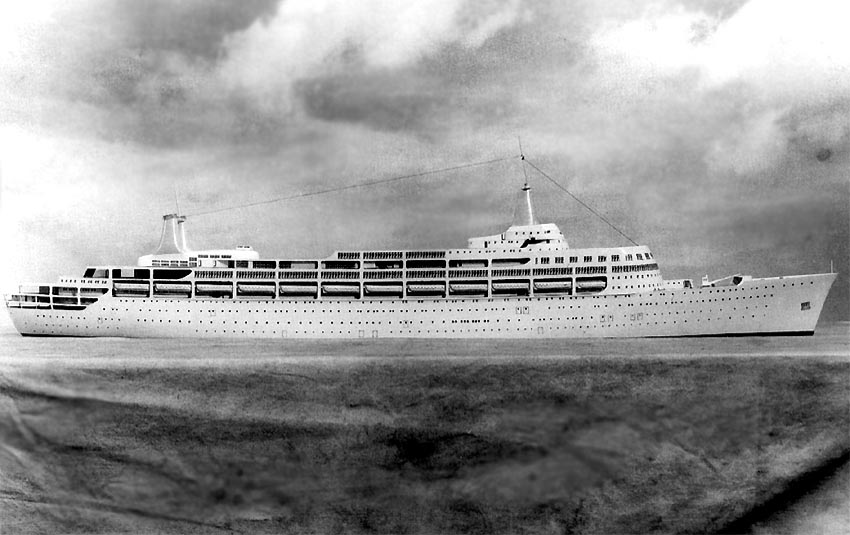
The early model of the Canberra
as was displayed as detailed in my story just a little further below
P&O-Orient Line called on Mr. John
West their head designer and the team from P&O's technical department, as
well as naval architects to commence on plans for their new as yet unnamed
ship, but they gave them one particular instruction and that was to provide as
much passenger space as possible. Thus what the designers did is look to a
number of recent revolutionary liners that had been built, such as the Shaw
Savill SS Southern Cross, being the world’s very first ever Passenger
liner with her machinery and funnel placed aft, but also the first passenger
liner not to carry any cargo, except for passenger baggage! The other ship
looked at was the revolutionary SS Rotterdam that also had her machinery aft,
but feathered those amazing and much spoken about aft, but twin side by side
stylised stovepipe funnels, which did their designed job superbly for no
exhaust ever touched the decks of the Rotterdam!
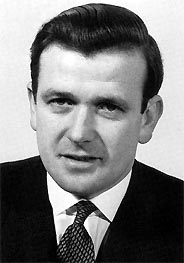
John West, a man who inspired the vision and
beautifully influenced the Canberra’s design-
However, there was one other feature that
made her special for that matter, for she would feature the innovative under
deck lifeboat stowage, thus all lifeboats hang high above the Promenade Deck,
rather than high above on Boat Deck. This was already featured on the Orient
Line’s SS Oriana. The idea is that a lifeboat will lower down just a
short way, until it is level with the deck. And as we now know, today every
cruise ship built operated on this system and is part of the official SOLAS
regulations, as it saves time and it is a much safer wat of entering a
lifeboat, should the need ever happen.
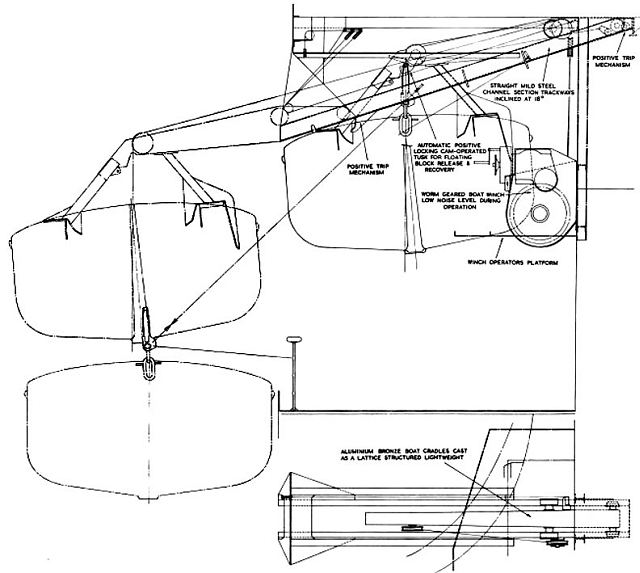

A pre launch impression of the new P&O-Orient
Liner SS Canberra and it clearly reveals her under deck lifeboat stowage
When the plans for the new liner had been
finalised and fully approved by the board of P&O-Orient in 1956, it was
time for them to approach the major British Shipbuilders to tender for their
new 45,000 GRT (Gross Registered Ton) liner. It was on December 20, 1956 that P&O-Orient
informed that Harland & Wolff in Belfast,
the very same company that had who had built some of the greatest White
Star/Cunard liners, had won the tender.
The building of P&O-Orient’s new
liner raised a great deal of interest across the Britain as well as Europe, and
for this reason for publicity purpose a large model of the ship was built and
it was to be displayed at the Brussels International Fair in 1958. Other models
were also displayed at Olympia
in London and
also at the “Queensland Centenary Celebrations” in Australia
in 1959.
The first steel for the new liner was cut
on Monday, September 23, 1957 and thus the first keel plates were laid. In
March 1958 the P&O-Orient Chairman, Sir Donald Anderson announced that
their new liner would be named the; “Canberra”
after Australia’s
Capital
City.
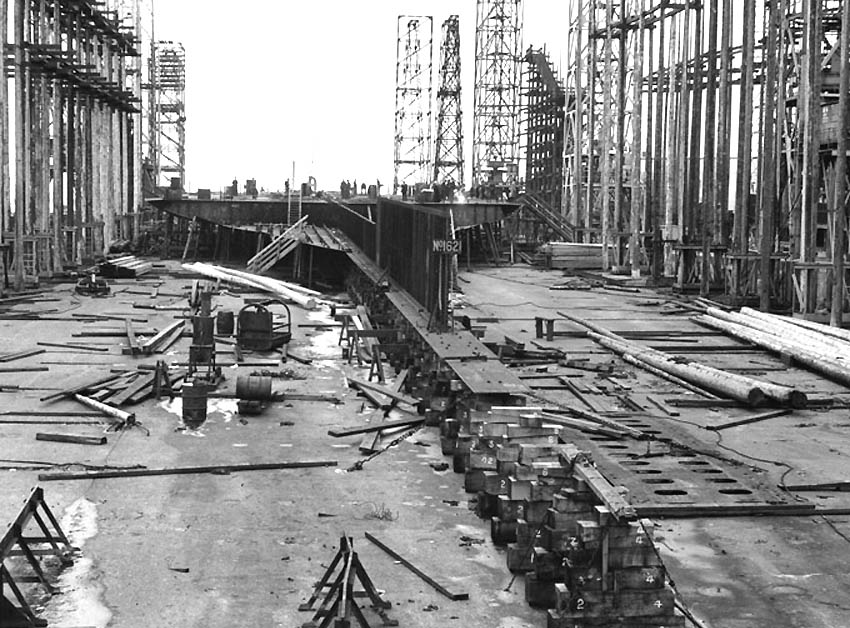
The laying of the ships keel, her first steel plates on September 23,
1959
Harland & Wolff Belfast
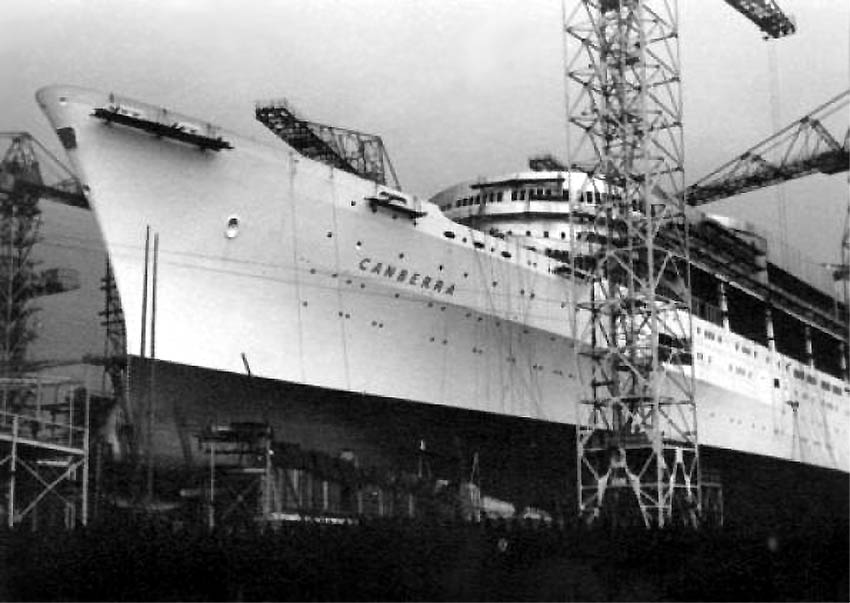
The Canberra see in the
Harland & Wolff stocks whilst getting ready for launching
Harland & Wolff Belfast
The
day of her launching on March 16, 1960 proved to be a miserable British cold
and a wet day in Belfast.
In fact it was so bad, that a flypast by a Canberra
bomber that had been pre-arranged to celebrate this special event was forced to
be abandoned. Yet three hundred guests gathered to watch the event, with
another estimated 11,000 onlookers were crammed in and around the shipyard and
other suitable spaces to watch her launching and slowly slipping into the
Musgrave Channel.
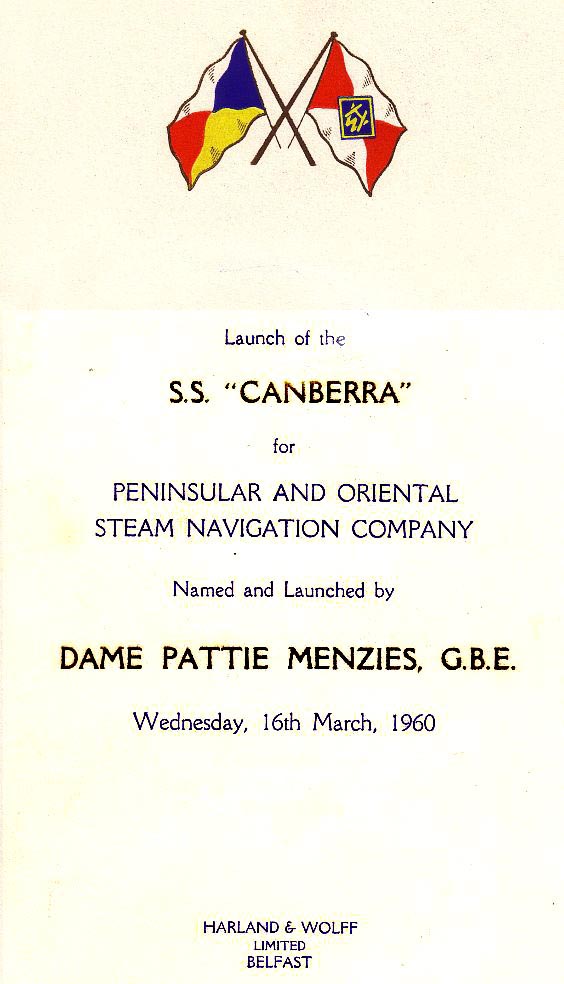
The cover of the official Launching booklet
Harland & Wolff Belfast
Just
before the launch on March 16, 1960, Dame Pattie Menzies G.B.E., the wife of
the Australian Prime Minister attached a sprig of white heather to the lunching
ribbon. Then, with a pull of the handle, the bottle of Australian wine Dame
Patti had brought with her smashed against the ships huge bulbous bow and Canberra’s
long sleek white hull began to slide down the slip into the Musgrave Channel.
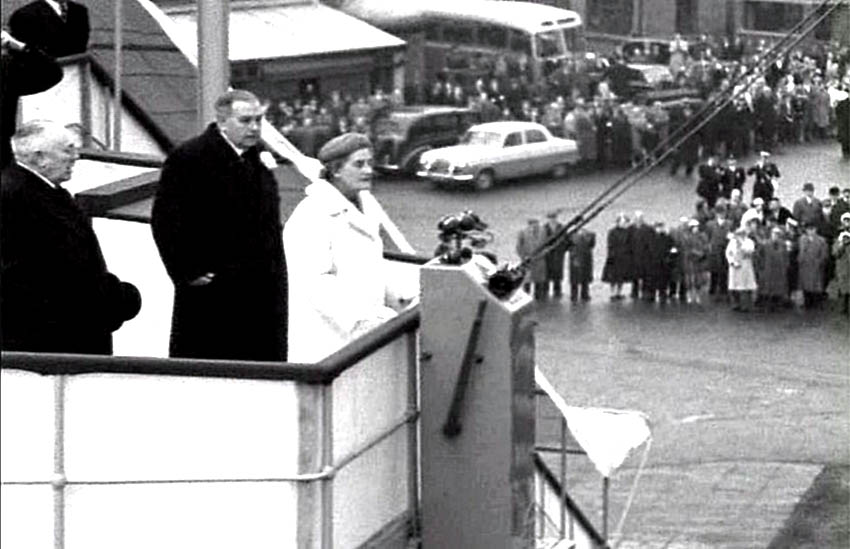
Dame Patti Menzies is seen here about to launch the
Canberra. Beside her is the Prime
Minister of Australia
Sir Robert Gordon Menzies,
KT, AK, CH, FAA, FRS, QC, and P&O-Orient Chairman,
Sir Donald Anderson
Harland & Wolff Belfast
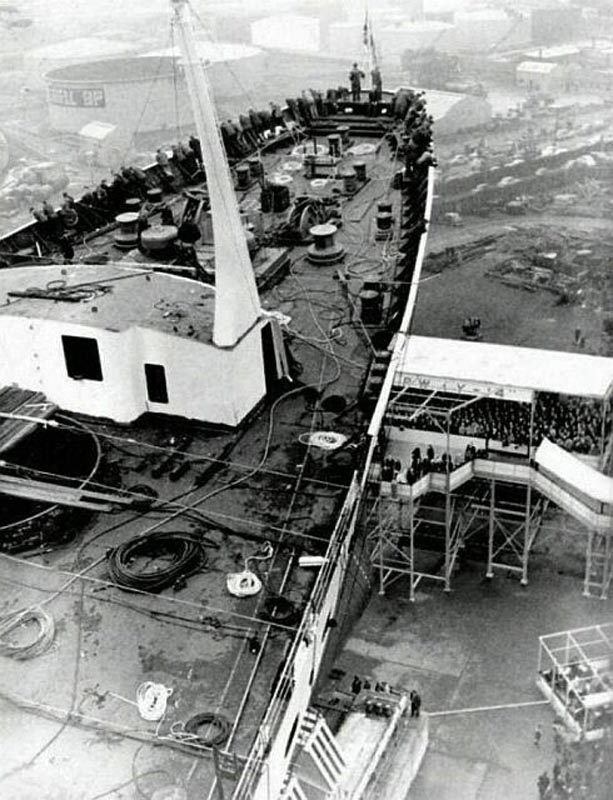
A bow shot towards the official party
Harland & Wolff Belfast
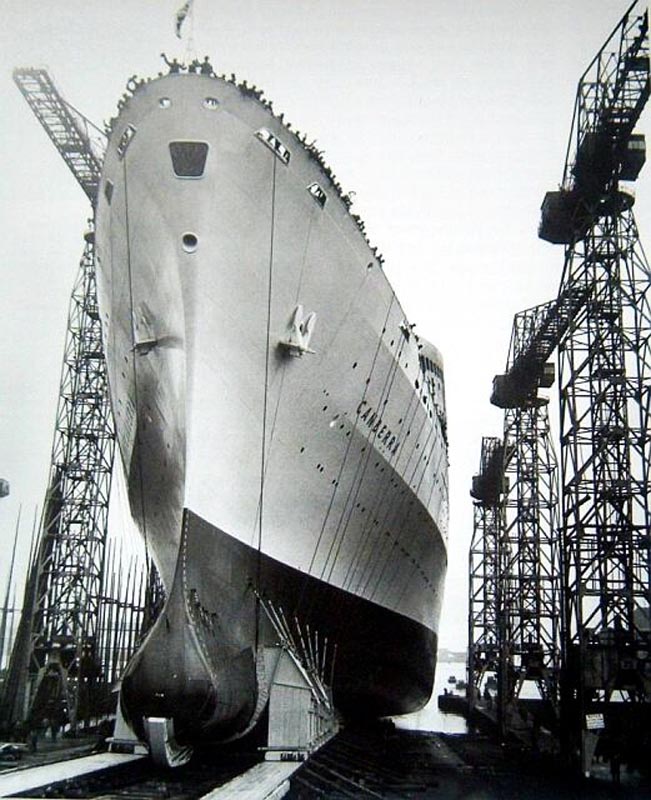
Here we see the Canberra
slowly sliding down the slipway
Harland & Wolff Belfast
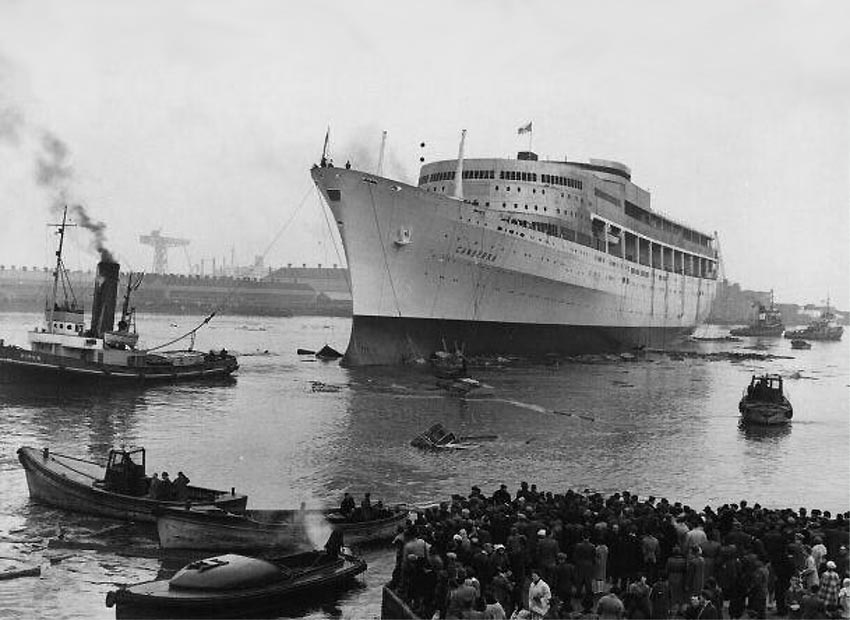
Finally the superb liner is in the water and ready
to be towed to her fit-our berth
Harland & Wolff Belfast
WATCH: Canberra Launched on YouTube
This is a worthwhile film originally made by
“Pathé Films”
Once the Canberra
was afloat in the Channel she was taken in tow and taken to Thompson
Wharf where she
would be completely fitted out as well have her upper superstructure and masts
and funnels fitted, etc! It would be eleven months after her launching that she
would be completed being in April 1961.
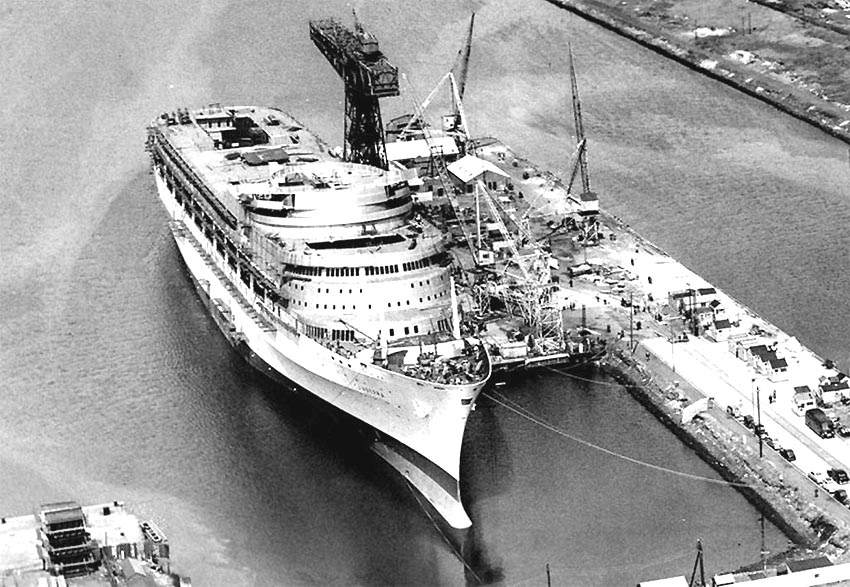
Canberra is seen here seen
during her early fit-out process
Harland & Wolff Belfast
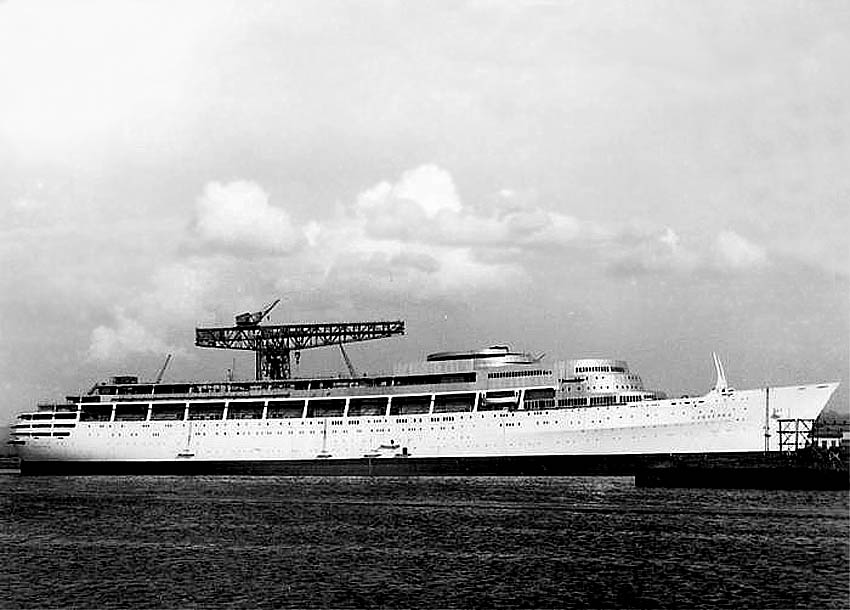
The Canberra
is seen at her fit out berth and we can clearly see her aluminium superstructure
Her topside superstructure is still being built up
and she has been painted white as far as Promenade Deck
Harland & Wolff Belfast
When
ready, the SS Canberra underwent her builders trials on April 29, 1961 in
Belfast Lough, during which time, when at full power, her massive bulbous bow
almost lifted clear out of the water. Mr. John West, her designer, the team
from P&O-Orient’s technical department were somewhat alarmed, as well
as her naval architects and builders from Harland and Wolff, but this was due
to the weight of her machinery that had been located aft and no ballast had
been added to offset this as yet!
She headed for Southampton
where some of her forward compartments were filled with correct number of tons
of ballast in order to act as a counterweight.
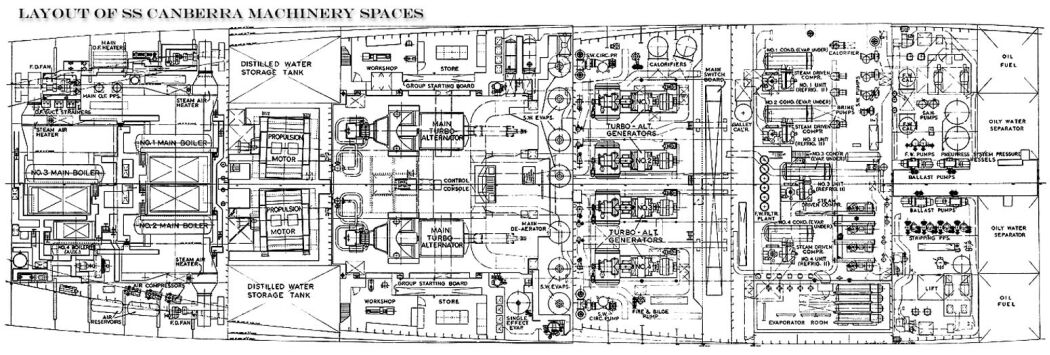
A complete view of her engine and boiler rooms, etc
Photographs are available on another page.
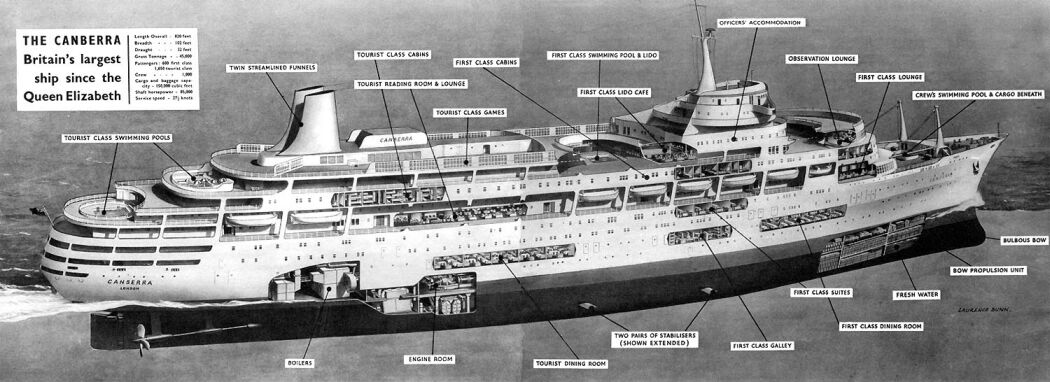
Above: Here we see an
excellent impression of the SS Canberra and view into parts of her interiors as
well as her engine room, etc. This image was provided to me by my dear friend
back in the 60s, a great maritime historian, the late Mr. Lawrence Dunn.
Completion & Her Acceptance Trials:
Having been in Southampton
for a number of weeks and with her final fit-out being completed; on May 18,
she headed out for her “Acceptance Trials” and sailing over a measured
mile off the Isle of Arran, SS Canberra achieved an amazing top speed of 29.27
knots, with her bow in perfect position!
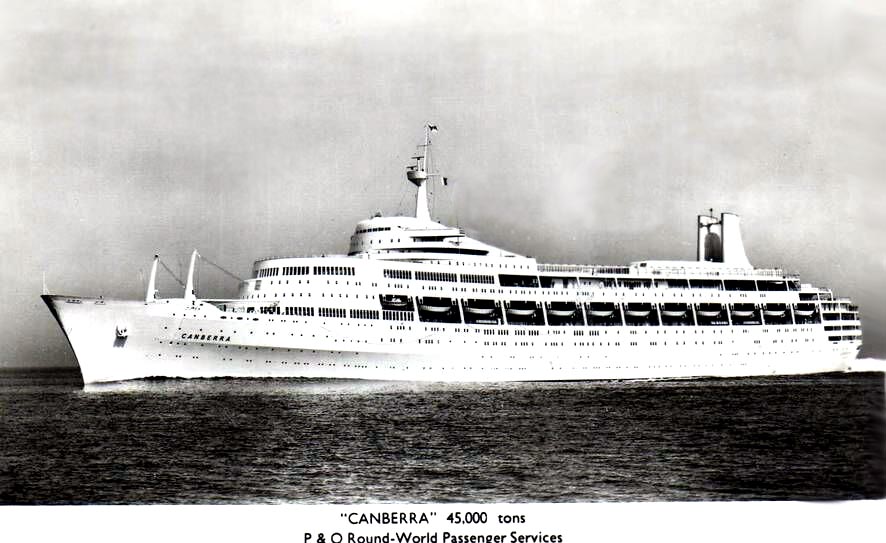
A
P&O-Orient Line postcard of the SS Canberra seen during her Acceptance
Trials on May 18, 1961
She is
seen off the Isle of Arran that is in Scottish waters
She returned to Southampton
having reached an amazing speed during her trials and it was assured that she
would be a successful ship in more ways than one. She was technically advanced
for her time, as well as one of the most beautifully designed and styled liners
to sail the globe! She certainly offered some of the finest onboard facilities
on an ultra modern liner, both in First and Tourist Class!
Whilst in Southampton she was stored up and made ready for her maiden voyage to
Australia
and New
Zealand.
The final cost of her construction and completion came to a grand total of
£17,021,000.
Besides the SS Canberra’s modern,
streamlined and distinguishing exterior features, there was a great deal more
to this fine new liner than just her good looks, for her interior spaces were
equally spectacular!
She has a large number of public venues
with a new style to any of the previous P&O-Orient liners, as her designers
created a whole new modern interior, yet retaining some classical touches!
Below are just a few images from Canberra’s
preview brochure, that was released early in 1961. For interest, there is a
separate page that contains further interior and exterior images!
First Class
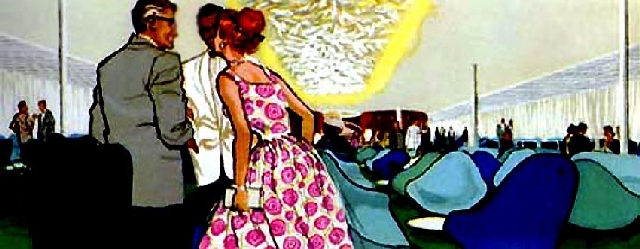
Forward
on Promenade Deck is the spacious Meridian Lounge with the Spiral Stairwell
that goes up 4 decks to Crow’s Nest
Located
far forward of the stairwell casing is, what became the very popular
“Century Bar” (First Class)
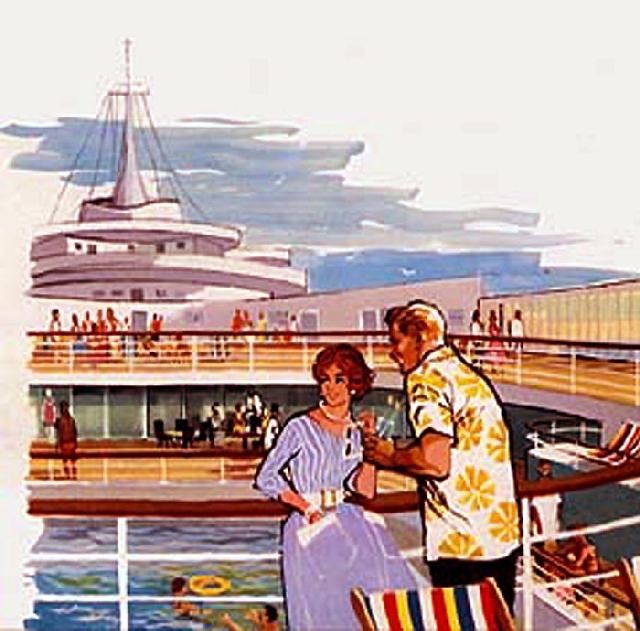
The
Bonito Pool is surrounded by sundecks and forward is the Bonito Club
Tourist Class
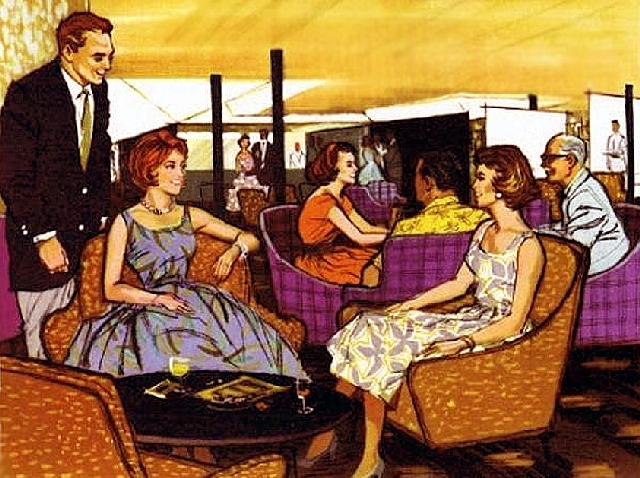
The William Fawcett Room is the Main Lounge and
Ballroom the perfect place for entertainment
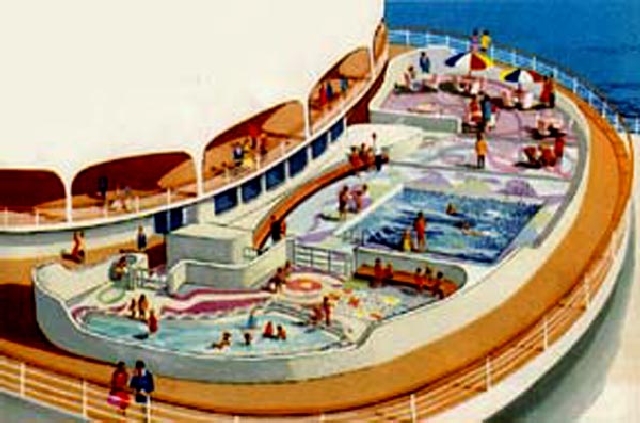
Here we see just one of the two aft swimming pools
Although the SS Oriana was the first to
feature the Court Cabins, however Canberra
featured many more Court as well as mini-Courts in both First and Tourist
Classes that the Oriana, in Cast Canberra offered a total of 58 Courts, which
were located on B, C and D Decks. The large Courts had three windows with
seating below them, whilst the narrower Courts had either two or just one
window, but all providing a view.
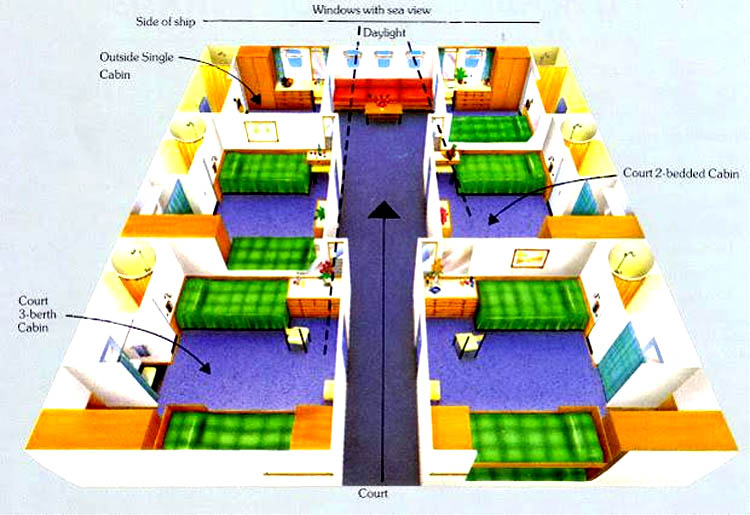
Here we see the general layout of six Court cabins
all with a view through a tall narrow window with a blind out to the sea
SS Canberra’s Maiden Voyage:
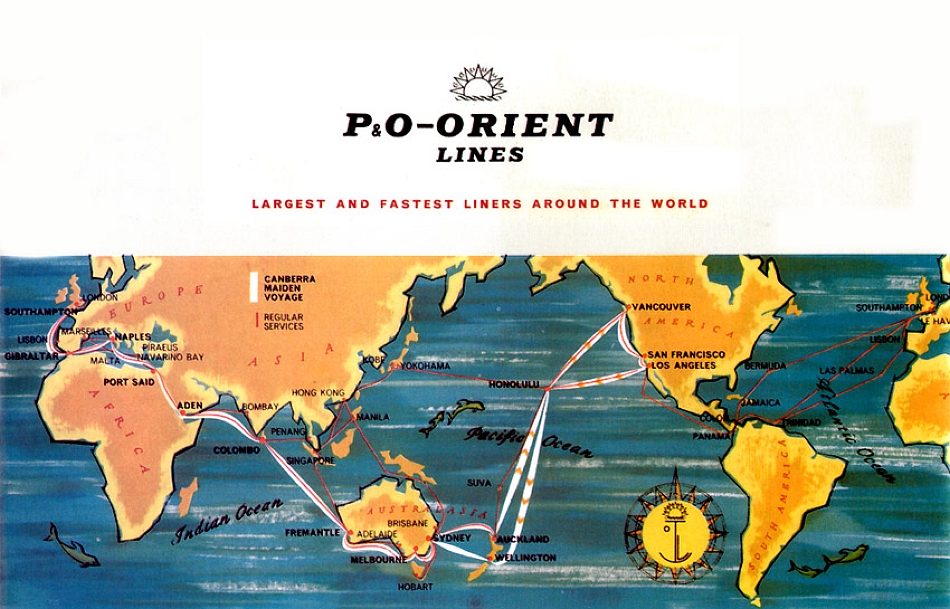
The P&O-Line Brochure covering Canberra’s
maiden voyage and there was a great deal of media
attention in relation to Canberra’s
maiden voyage as well as her many outstanding facilities
Finally the day came, on June 2, 1961 just
before 5 PM the 45,270 GRT SS Canberra departed Southampton
for her maiden voyage. At her helm was Commodore Geoffrey Wild, who was made
the fleets Commodore only one day earlier, as he had been an outstanding
Captain!
There had been an amazing blast of
publicity and it certainly paid off for a good 2,238 passengers had embarked
the new liner, thus she was fully booked ship!
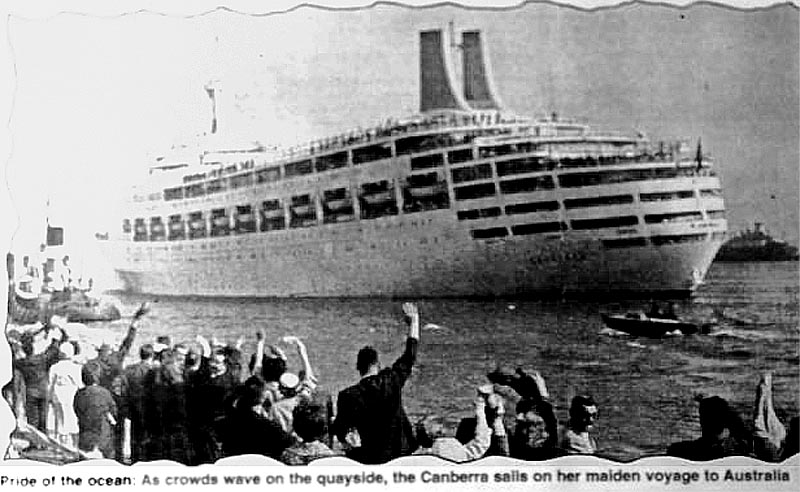
This is a newspaper clipping from the Southampton
News of the departure of the SS Canberra on June 2, 1961
I know that it is in a poor state, but it was
scanned and sent to me by a dear old friend in 1994!
Obviously being able sail on a maiden
voyage aboard a great new passenger liner as exciting as the Canberra
was not something that did not happen every day. Thus there were some
passengers on board that had booked to sail only as far as Gibraltar or Naples,
although they were the minority. No matter what, in Tourist class there were
750 emigrants on board who were setting off to commence a new life in Australia
as well as another 120 persons who were heading for Auckland New Zealand.
How fortunate were they to be able to sail on Canberra?
However whilst in the Mediterranean
there would be a surprise encounter! As she headed Down Under and Canada
and America
regardless where she arrived, there would be all manner
of spectacular arrivals and tributes to grand new liner, for she was indeed a
spectacular sight!
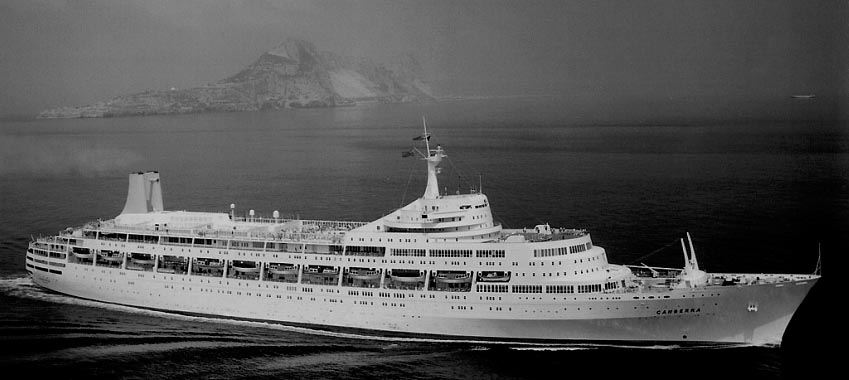
The Canberra is seen just off Gibraltar
having just visited the port
The aging SS Strathaird had been on her
final voyage to Australia,
and she departed Sydney
for the very last time on May 9, 1961 sailing via Melbourne,
with her final port in Australia
being Fremantle (Perth).
She then headed through the Suez Canal and then whilst in the Mediterranean
she passed SS Canberra which was on her maiden voyage. Whilst the Strathaird
was on her final leg of her career, the Canberra
was just beginning her long and what proved to be a most successful career!
Strathaird’s Captain Clay sent the
following beautiful message from his radio room; “from Strathaird to Canberra”:
“You look magnificent, and all in Strathaird wish you a happy and
successful voyage, and from old to new, Strathaird bids you farewell.”
In reply Commodore Wilde replied:
“You too look magnificent with your paying off pennant flying gaily. You
look a gracious and not too elderly lady. All well here.” …
Although, I must say that what the Commodore said was far from the truth! Reuben
Goossens.
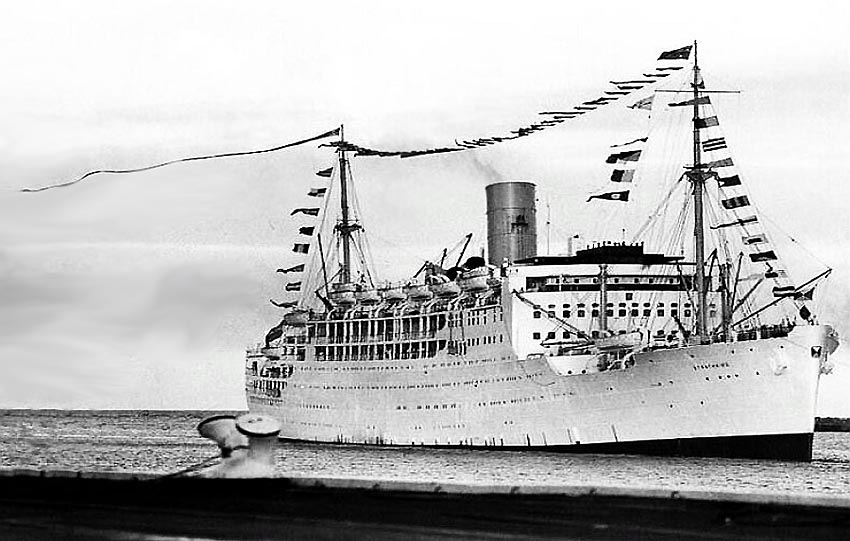
The Strathaird is seen departing Fremantle with her
extra “Long Service Pendant” flying from her main mast
She and her sister would be heading very soon for
the breakers in Hong Kong.
Commodore Wide had stated to the Captain
of the Strathaird “All is well here” but the truth was in fact that
down in the engine room all was certainly far from being “all
well,” for there was a big problem with one of the condensers as saline
had been found in the distilled water that had most likely been caused by leaky
tubing. The problem had caused the Canberra
to miss her southbound Suez
convoy. Whilst in Aden
the ongoing problems caused a 14-hour delay for Canberra
had now suffered a complete power failure.
On board passengers and crew was suffering
with shocking heat as there was no air conditioning. The passengers were
advised that they could take their bedding up on deck for the night if they so
desired! The ship departed and arrived at Colombo
12 hours behind schedule, and then after she departed her speed was forced to
be reduced as the condenser problem reared up once again.
By the time she finally reached in
Fremantle (Perth) Australia, she was a good thirty-one hours behind schedule,
yet as SS Canberra reached the inner harbour and terminal there were countless cheering
crowds as well as cars along the shoreline with their horns blowing. Thousands
of people had flocked to the shoreline to get a glimpse of the highly published
P&O-Orient Lines new “Ship of the Future." Canberra
may have been late, but she was a huge hit with the people of Perth,
Western Australia, for she was a
sight for sore eyes, such a beautiful and a sleek liner, she was like nothing
that they had ever seen being so different to any other ship, including the
recently completed SS Oriana! Sailing from Fremantle her next port of call
would be Melbourne
however, during this long voyage along the southern coast of Australia,
but due to further problems with her port condenser sadly her engineers were
once again forced to reduce her speed.
Finally she arrived at the entrance of
Port Phillip Bay on June 27, and she headed for Port
of Melbourne
where there was a huge crowd awaiting her, as well as a very special VIP
awaiting the Canberra
at Station Quay, being Dame Pattie Menzies who launched the liner in March
1960. She boarded the ship and enjoyed two nights on board sailing north to Sydney.
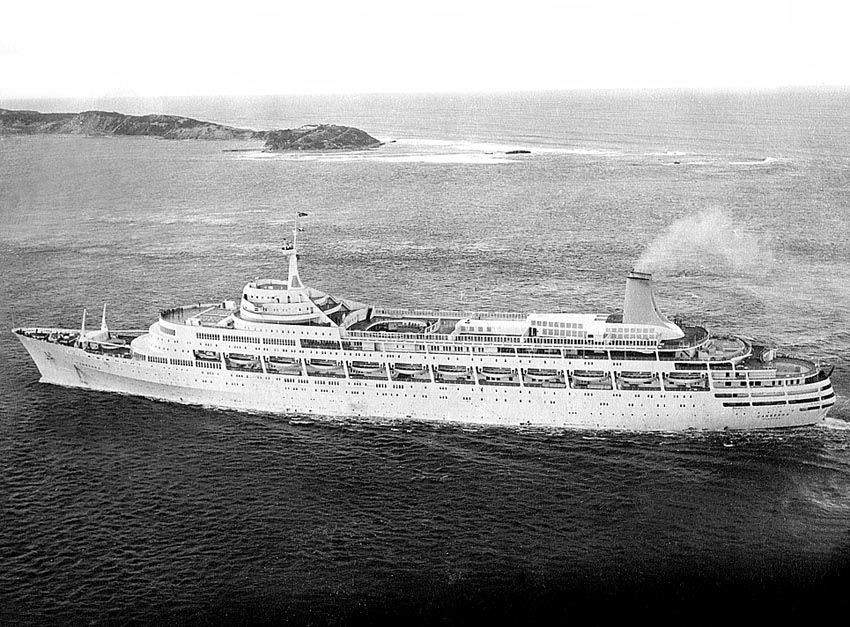
SS Canberra is seen entering Port Phillip Bay
heading for Melbourne on June 27
The welcome received in Sydney
on June 29 was massive, even though the Canberra
was around 24 hours behind schedule. But it seemed that the huge crowds simply
did not care, for there were hundreds of small yachts and motorboats escorting
her from Sydney Heads towards her berth. There were countless thousands of
well-wishers crowded along the shorelines; they stretched from the Heads all
the way to the International Passenger Terminal and along Circular Quay! Her
arrival seemed more like a festive event!
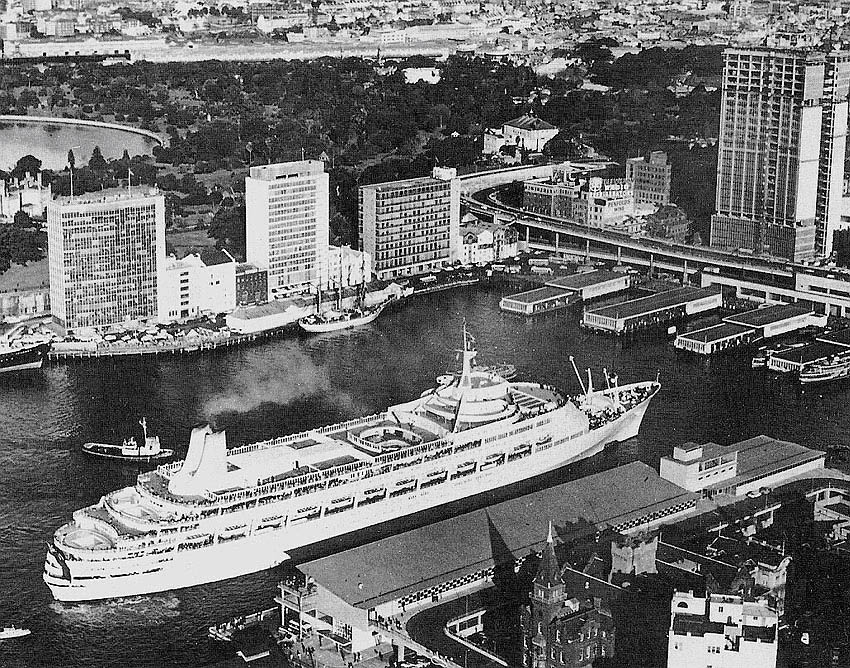
Canberra during her maiden voyage pulls
into her berth in Sydney on June 29
Once she was safely alongside,
P&O-Orient Lines, Sir Donald Anderson gave an official press conference,
where he explained that the condenser trouble, which had obviously been well
publicised, had now been rectified. And the truth was for the time being he was
correct for the condenser had indeed been fixed.
Canberra’s
maiden voyage generally without any further problems, although you cannot blame
the weather of course, for having sailed across “The Ditch” a
popular local term for the Tasman Sea she headed for Auckland New Zealand.
But even her arrival to Auckland
on July 6, was not completely without problem, for she was forced to delay her
berthing for a several hours due to extreme fog and it was reported as being
the worst fog experienced in Auckland
for a good 30 years! But again there was a huge crowd, as well as the author
who can be seen in the photograph at the top of the page in my introduction.
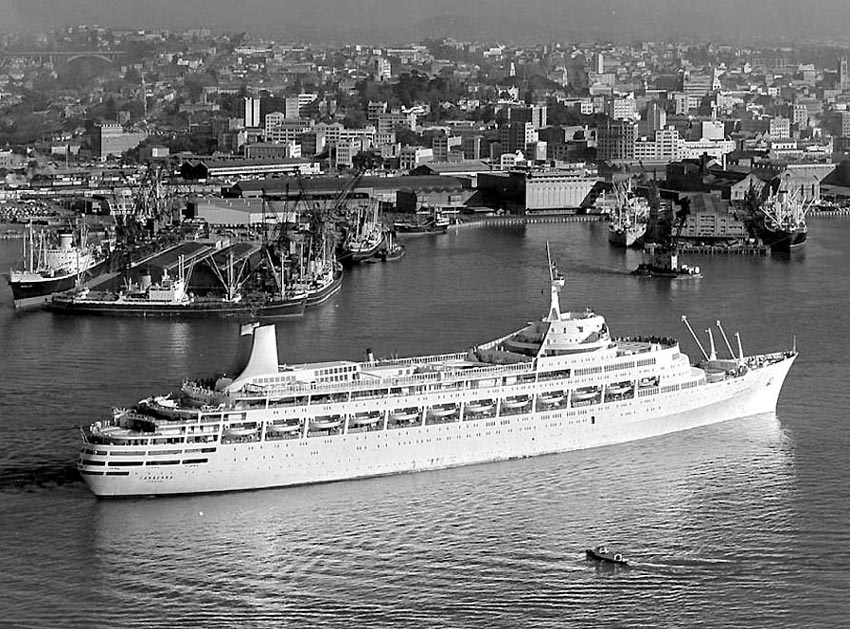
SS
Canberra is seen in Waitemata Harbour Auckland New Zealand on
July 6, 1961
Photo by Whites Aviation Photos NZ
From New
Zealand
she would undertake a Circle-Pacific Voyage, with ports of call being: Honolulu,
Vancouver,
San Francisco,
Los Angeles,
Honolulu
and return to Wellington New Zealand
completing the Pacific-Circle Voyage. Many had booked this as a one way or a
return voyage from Australis ports, as well from Auckland
and the New Zealander’s would disembark in Wellington.
However, Honolulu
had officially declared July 12, as “Canberra Day.” Next there were
hundreds of small boats that came out to meet and greet her at Vancouver.
Amazingly, as she arrived at San Francisco where the Canberra was given a
13-gun salute from Telegraph Hill as she made her way to pier 32 being the
famous Matson Lines Pier. Then as she continued down along the coast to Los
Angeles
she was given a 50-gun salute and a display of world champion water-skiers was
laid on.
Her return voyage was via Honolulu
and as she arrived at Wellington New Zealand
she was greeted with force 12 winds that delayed her arrival. Next it was Sydney,
Melbourne,
Fremantle, Colombo,
Aden, the Suez
Canal, Naples
and Gibraltar.
SS Canberra returned home to Southampton
at 10.45 AM on Monday, September 4, 1961 and as it turned out, she did shorten
her passage time from Sydney
by a full week. She had steamed approximately 42,000 miles and even with her
troubles with the condenser during her voyage to Australia,
Canberra’s
voyage was hailed a success. And P&O-Orient considered that that her
condenser malfunctions were “just an irritating teething problem.”
Although it had certainly been a costly most one!
The ships second voyage was
scheduled to depart at 1.30 PM on Friday September 22, 1961 however some time
earlier there a minor fire was discovered in pipes in the engine room. Although
the fire was soon extinguished, yet there was a five-hour delay in the ships
departure. Thus not a great start to her second voyage to Australia!
Like her maiden voyage, she headed for
Gibraltar for a short stay, she then sailed across the Mediterranean to Naples
Italy,
after which she transited the Suez Canal and onto Aden.
But then another problem occurred, for sailing between Aden
and Colombo a
blade in one of the main turbo-generators broke and this forced the ship to
reduce speed by five-knots, and her voyage continued at just 22 knots until
arriving in Sydney
on October 18 and repairs were made. She departed Sydney
two months later on December 18 and headed for Southampton
sailing at full speed.
SS Canberra’s third voyage to Australia
passed without serious incident, but then came her fourth voyage, that departed
on April 19, 1962 and yes, sadly this was another troublesome voyage to say the
least. The ship suffered three major problems; with her boilers, then her
distilling plant as well as the main turbo generators. P&O-Orient Line had
to decide to do something, for they had to keep up their reputation! Thus they
decided that the voyage would be shortened and instead of returning home via Australia
and Suez from
the USA,
she would return direct by transiting the Panama Canal for the first time and
head home for Southampton
as soon as possible. Amazingly at that time, Canberra
was the largest ship ever to pass through the Panama
Canal on June 11, 1962 and P&O-Orient
were charged £11,500 for Canal fees. When she arrived on the Atlantic side she
had a slight scrape to her side, despite only having 3.6ft-In clearance on each
side at the narrowest points. She stopped briefly at Willemstad,
Curacao; she then headed for Trinidad and then headed directly for Southampton.
It was reported that in Trinidad,
nine stowaways had boarded. During the voyage home the ships Air-Conditioning
broke down and for a number of nights certain passengers decided that it was
better to sleep up on deck, for it became unbearable below!
Canberra
arriving home to Southampton
on June 21, 1962 where she received a 29-day overhaul to correct all her
recurring problems, and also, it was decided to make a few modifications to the
ship’s appearance. The First Class stadium, the sheltered games area on
Games Deck was not a popular or a much-used area as was. Thus, a retractable
deck-head was welded in and the area below was turned into a new
theatre/showroom. Air-Conditioning units for this area were for some strange
region only later added, but they were never very effective. Whilst a good
amount of other works were also undertaken.
With all repairs completed and all
machinery having been meticulously checked and rechecked, the Canberra
was deemed as being in A1 condition, but her Gross Registered Tonnage had
increased somewhat to 45,733 GRT.
With the Canberra
all ready to set sail again, and it had been decided for her to undertake a
seven-day cruise to Gibraltar and Madeira,
which was a popular cruise, and exceedingly well booked.
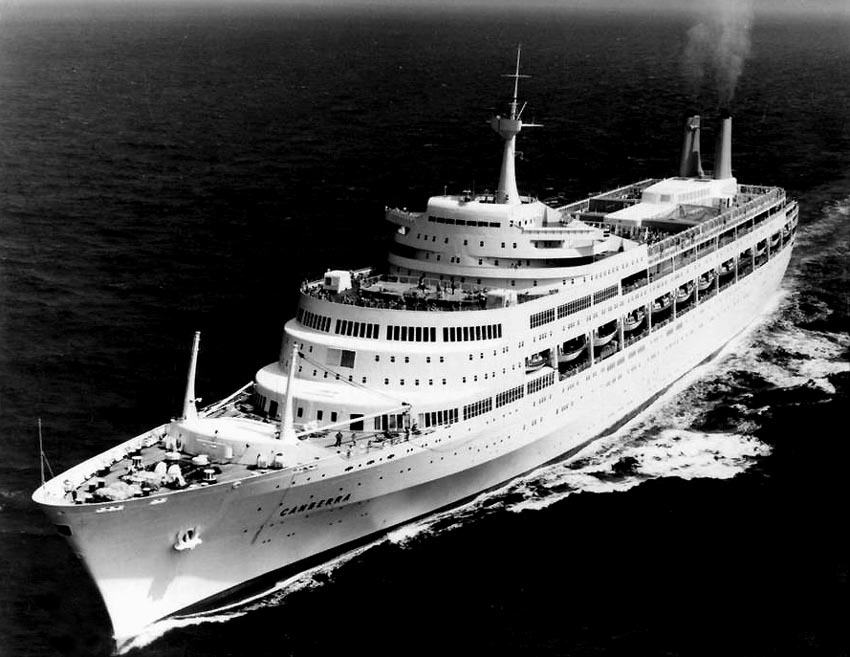
SS
Canberra is seen after her refit with the sport stadium enclosed and her funnel
extensions and whilst on her first cruise
Her next cruise would be more of a major
event, for this time she was about to break with tradition for the SS Canberra
was about to do something out of the ordinary! The truth was that she was about
to undertake a return Trans-Atlantic sailing to New York and it had been 100
years since a P&O-Orient liner had visited New York. As the SS Canberra
arrived, she was given a tumultuous welcome to New
York City, in fact it proved to be
such a big event that the Canberra
was featured on the NBC show as a “Canberra Special.”
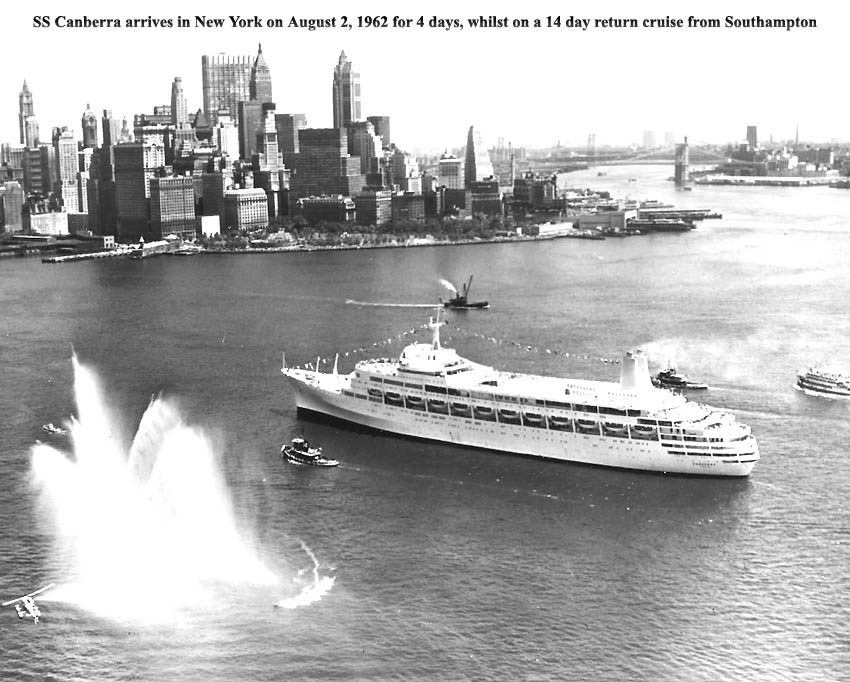
SS Canberra
is seen during her maiden arrival in New
York on August 6, 1962
Publicity photograph received from P&O-Orient Lines in January 1963
PLEASE NOTE
For
a wonderful YouTube 50 second newsreel of SS Canberra sailing into New
York Click HERE or the Photograph Above!
She was berthed alongside Pier 91 and the New
York press and travel agents
were everywhere and they waited eagerly to board this beautiful sleek looking
white liner and see all the beauty of the much-publicised interiors of the new
ship.
Having spent four-days in the Big Apple
the Canberra returned to Southampton and having arrived she returned to New
York again the very next day! And four days later she sailed home again to Southampton.
Her next cruise was a 13-day cruise to the Mediterranean
which was booked out. When she returned to Southampton
this concluded her first and a very successful cruise season.
The fifth voyage to Australia
was to be the last for Commodore Wilde as he would be replaced by Captain
Leslie Hill. Later during the voyage, and sailing between Vancouver to San
Francisco, on November 1, 1962 the Canberra collided with a steel barge whilst
she was in dense fog, but thankfully Canberra was not damaged, except for some
paint having being scraped off from her white hull.
But sadly her troubled past was
about to catch up with her again for at around 4 AM on January 4, 1963 the Canberra
was sailing eastward at good speed of 27 knots across the Mediterranean
with 2,222 passengers on board. Being about 160 miles north-east of Malta,
one of the officers in the engine room saw that one of the three
turbo-generators had “shed its load.” As the generator began to
speed up, the crew were unable to trip the circuit breaker, and then one of the
crew forcibly broke the contact and that was in spite of the sign warning not
to do this. It created a considerable electrical arc that caused a fire that
was fed electrically by the other two generators and this then destroyed the
starboard side of the switchboard and the majority of the electrical
distribution cables. Canberra
suddenly lost all power and suddenly alarms rang out throughout the ship.
With no electrical power, the engines
could were out of commission and there was no lighting, no air-conditioning,
ventilation or power for the galley. Parts of the lower decks also began to
fill with smoke and passengers were ordered to their muster stations.
Thankfully the ship it self was not in danger, thus the lifeboats would not be
needed as the fire was soon under control.
Thankfully the P&O liner Stratheden
had left Port Said
just several days earlier and was diverted to assist the Canberra.
In addition, two Royal Navy ships, the Lion and Scorpion that were exercising
in the region had also been asked to assist and they also headed towards the
stricken Canberra and an RAF Shackleton AEW aircraft that was based in Malta
was also sent to overfly the ship and keep an eye on things.
Early in the morning the Stratheden had
arrived on the scene and had supplied the Canberra
with ample fresh bread and other stores as requested. Early in the afternoon
the ship's engineers and electricians had worked hard and they had managed to
restore power to the main engines and the ship was able to get underway at just
4 knots, to Grand
Harbour
at Malta,
where repairs would be carried out. However, they managed to increase her 4
knots to 10 knots, and Canberra
was able to arrive at Malta
by 9 AM the next morning, January 5.
Back in London,
big plans were underway to get all passengers back to their destinations, and
it would be the big “Malta Airlift” as it would become known. The
scheme was fully planned someone who later became well known, Mr. Freddie
Laker.
Within a week, some 14 aircraft had been
chartered and P&O soon managed to fly 1,700 passengers to their
destinations, most of which went to Australia
and New
Zealand.
However there were some passengers who simply refused to fly, and they either
continued on other ships or with Canberra
back to England.
It was a massive task, but it was bad publicity for the poor struggling Canberra!
On January 14, 1963 the Canberra
departed with 46 of her original passengers still on board, for they had
refused to leave ship no matter what. But even as she headed for Harland &
Wolff Shipyards, her builders in Belfast
she encountered 60-knot winds, but arrived on January 21, 1963 and she would
undergo further repairs and a new switchboard was installed. The Canberra
being out of commission for around four months and she was also given another
general overhaul.
With all repairs and works completed it
was time for her sea trials and she departed very early in the afternoon of May
11, SS Canberra left Belfast
and headed for the Irish Sea.
Then on May 14, she dropped anchor off the Isle of Wight and the next morning
she entered No.7 Dry-Dock in Southampton
for an underwater hull inspection.
Finally the Canberra
was back in top condition and ready to return to her regular schedule. On
Friday May 24, 1963 she departed Southampton bound for Australia
and New
Zealand
and as it turned out, she had a record 2,266 happy passengers and emigrants on
board.
First Class Dining Saloon Staff 1963:
Some time ago I received an
email from the First Class Dining Room steward Eddie Groody who served aboard
the Canberra in the sixties between May 1, and November 8, according to his Log
Book he sent me and seen below. As we can see he also served on the SS Orion
and the wonderful SS Himalaya.
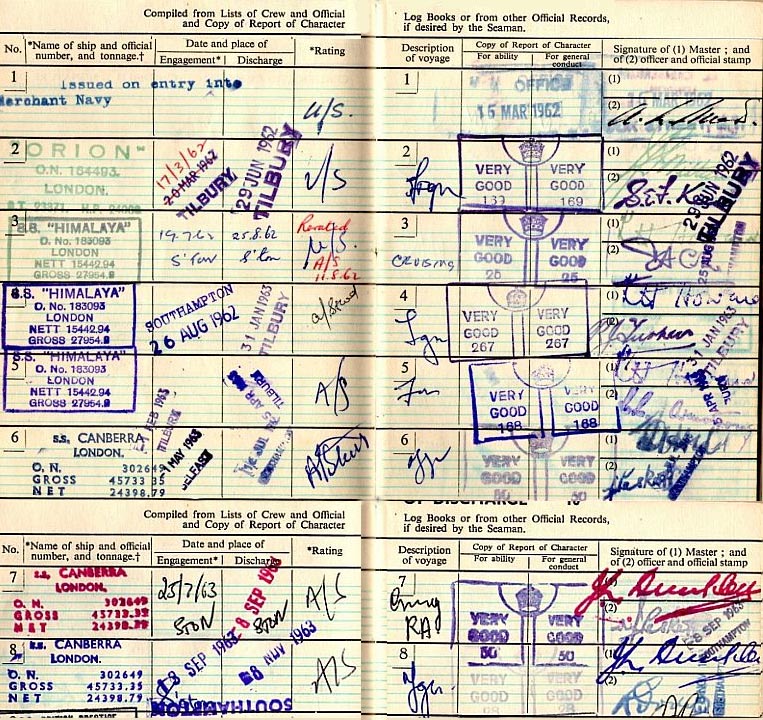 --
--
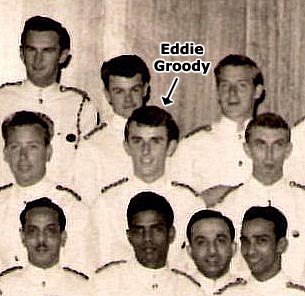
Eddie was kind enough to send me an
excellent photograph of the First Class Dining Saloon staff that was taken
during one of the voyages in that year, thus obviously it was after lengthy
repairs in Belfast
after her breakdown, as described above. Eddie has provided the names of those
he was able to recall and I have numbered these and placed the names below.
However, if any of my readers, passengers
or past crew members can provide further names, these would be appreciated.
Email me at rg@ssmaritime.com. Thank you
Eddie for your contribution and providing some wonderful memories of her great
days of sailing!
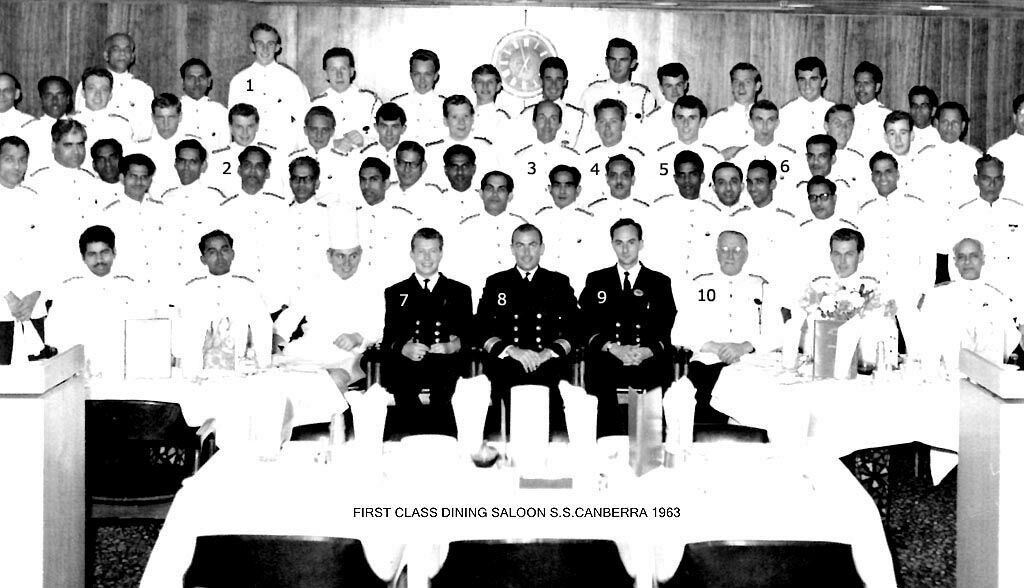
Back
row from left: 1. Andy Cruickshank
Second
row centre: 2. Jeff Crippen,
3. Peter Smith, 3. Matt
Doyle, 3. Eddie Groody & 6. Mark Lindsay,
Front
row seated from right: 7. Mike
Quinn, 8. John Webb - Dining Room Head Steward, 9. Noel Coward - Asst Head
Waiter, 10. Wine Steward Wally Baines.
Since placing the original photo
online with Eddie’s provided names, and I have indeed received further
emails from other past crew members and therefore you will find these noted in
the credits below, for I am most grateful to them all!
Credits:
Photograph & names
of 1 & 3 to 5 were provided and owned by Eddie
Groody & used with permission.
Number 7 the
Assistant Head Waiters’ information was provided in Oct 2011 by the
Assistant Head Waiter from the Tourist Class Restaurant, Geoff Cook (not shown) who shared a cabin with Noel Coward.
Dining Room Head
Steward John Webb advised me regarding his (8) and Mike
Wally’s (10) names in 2013.
Whilst in 2022 Jeff Chrippen
contacted me and told me that he served
on Canberra from1963/1964, joining her in Southampton
as a first class steward. He said that when he saw the photograph
“This brings back very fond memories of a great ship mates and what
a pleaser it was to serve on such a happy ship”.
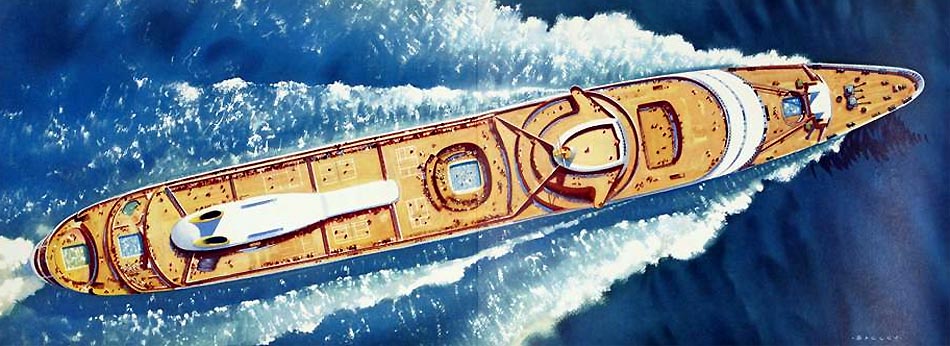
A fine
aerial view of SS Canberra, showing off huge amount of deck space!
P&O-Orient Lines Promotional Department
The Canberra
sailed on, however it would come soon apparent that times were changing and
P&O had to change directions. Page Two will continue her story, which will
also include her heroic Falklands
account and her concluding days until being sold to the breakers. Gladly I did
sail on her in 1996, thinking it was going to be her last “World
Voyage,” but as it turned out she had just one more in her in 1997. Page
Two contains a great deal as well as photographs, brochures and links to
some very interesting items I have on file!
***********************************
Please Note: The SS Canberra INDEX below is still
incomplete as there are many further pages to come, such as Canberra’s
early interiors and her first 1961 First and Tourist Class Deck Plans. Then
there are her One Class 1973 Deck Plans. In addition I have a review of my
cruise on the Canberra
in 1996 which is combined with an extensive photo album of the Canberra
at the time, which is combined with her 1996 Deck Plan. For interest, each deck
plan can be clicked and a full size plane will be revealed for better details
to be seen! I expect there be at least 6 or seven pages when completed!
SS Canberra INDEX:
Page One: Canberra
in building and history 1961 to 1963.
Page One A: Canberra’s
Illustrations and Photo Page of 1961.
Page
One B: Canberra
1961 Provisional Deck Plans - First & Tourist Class.
Page Two: Canberra
the Cruise ship & her Falklands
days, to her end in 1997.
Page Two B: Canberra
1973 & 1996 Deck Plans - One Class.
Page A: Four Page
interiors of Canberra’s
Final Cruise Log.
Page
B: The Bill of Sale of the Canberra
to Pakistani breakers.
***********************************
A MovieTone Newsreal of the launching of
the SS Canberra
Also Visit our
Features on the following Orient Lines/P&O Ships
Orient Lines: RMS Orcades
– SS
Oronsay - SS Oriana
- RMS Orion
P&O: RMS Strathaird - SS Iberia - SS Canberra - RMS Kaisar-i-Hind
There May be more since this page was created
– See our MAIN INDEX
****************************
Visit
our ssMaritime Main INDEX
Where you will discover more than 1,550 Classic Passenger &
Passenger-Cargo Liners!
ssMaritime.com & ssMaritime.net
Where the
ships of the past make history & the 1914
built M.S. Doulos Story.
The
Author has been in Passenger Shipping & the Cruise Industry for well over
60 years
In
addition he was the founder of “Save the Classic Liners Campaign”
in 1990.
Please Note: ssmaritime
and associated sites are 100% non-commercial and the author seeks no
funding or favours of any shape or form, never have and never will!
Photographs on ssmaritime and associate pages are by; the
author or from the author’s private collection. In addition there are
some images that have been provided by Shipping Companies and private
photographers or collectors. Credit is given to all contributors. However,
there are some photographs provided to me without details regarding the photographer/owner
concerned.
This notice
covers all pages; although, and I have done my best to ensure
that all photographs are duly credited and that this notice is displaced on
each page, that is, when a page is updated!
ssMaritime is owned & © Copyright
by Reuben Goossens - All Rights Reserved































 --
--



